This ice excavation science activity is perfect for preschoolers on a hot summer’s day. It’s a great way to help them learn about states of matter by melting ice themselves and uncovering hidden objects. Plus, it’s a lot of fun! All you need to do is freeze fun objects in a block of ice, then let the kiddos work to uncover them!
Keep reading to see how we did this fun activity. You can also jump right to the steps if you’d like.
What is the ice excavation activity?
This is an excellent activity for young scientists – Especially for summer science on a hot day! Learn why we think science for kids is so important in this post.
All you need to do is choose which items you want to freeze and you’re ready to create an ice block! Then, using some simple tools and their imaginations, the kids can ‘rescue’ the frozen materials (or pretend that they’re archaeologists).
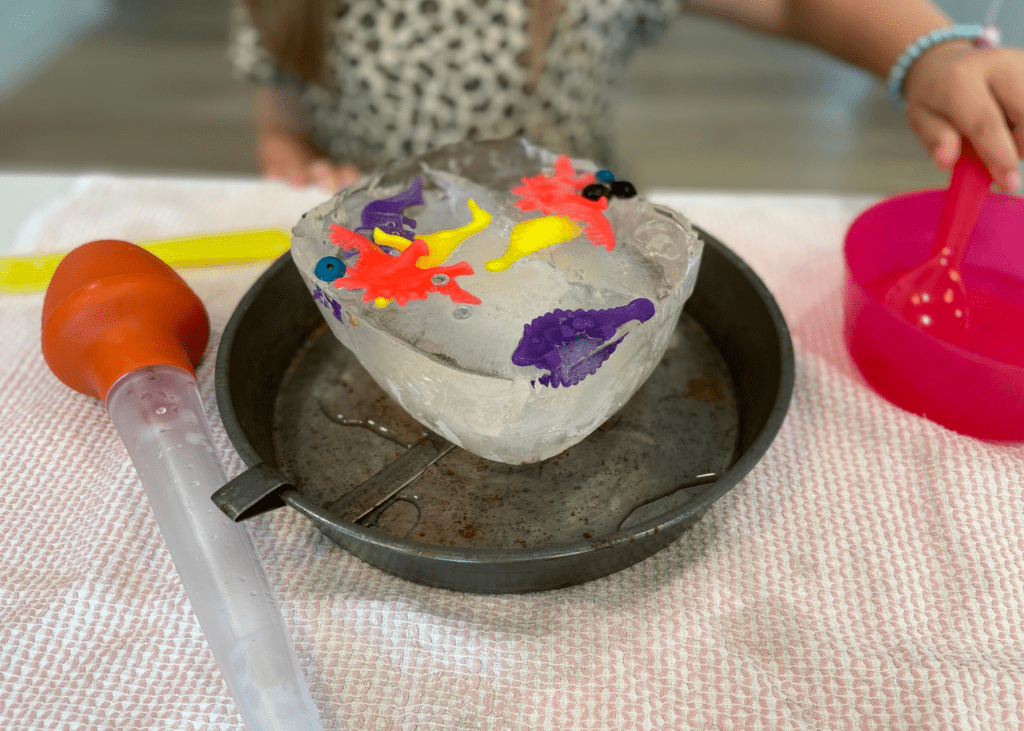
Download a scientific method worksheet before starting
This is totally optional, but you may want to head over to my TpT store and download the Scientific Method worksheet for free. This way, you can emphasize key learning moments while introducing your preschooler to the scientific method. By practicing this, they will become confident in their ability to hypothesize, test, and evaluate experiments!
Plus, if you write down the step-by-step instructions and tuck this away in a folder for later, they can re-create the same activity another time.
How to create the ice excavation experiment
- Freeze the ice block: Fill a container a third full with water and add some of your small toys or objects. Then, place it in the freezer for a few hours.
- Layer your items as many times as you’d like! I usually do three layers. This makes sure there are objects frozen throughout the ice block rather than just at the top and bottom.
- On the last layer, leave it in the freezer overnight to make sure it has time to freeze solid.
- Prep the ice: The next day, take the ice out of the freezer and let it sit at room temperature for a few minutes. While it’s sitting, ask your kiddos how they think they could excavate the objects from the inside (I’ll put a list of suggestions to help prompt them). Gather your materials and melt away!
- Excavate the objects: Using whatever the kiddos can think of, try to melt the frozen block!
This is a fun idea for simple science (among other learning opportunities!) The children will be super excited to find all of the hidden items – It’s been a hit whenever I’ve done this activity!
BTW: Don’t use any fancy containers for this! Ice expands when it freezes, so freeze your ice in recycled containers if you can, so if anything cracks as it freezes it’s no problem.
Make sure you put the ice block into a plastic container or something similar to catch the melting water, btw!
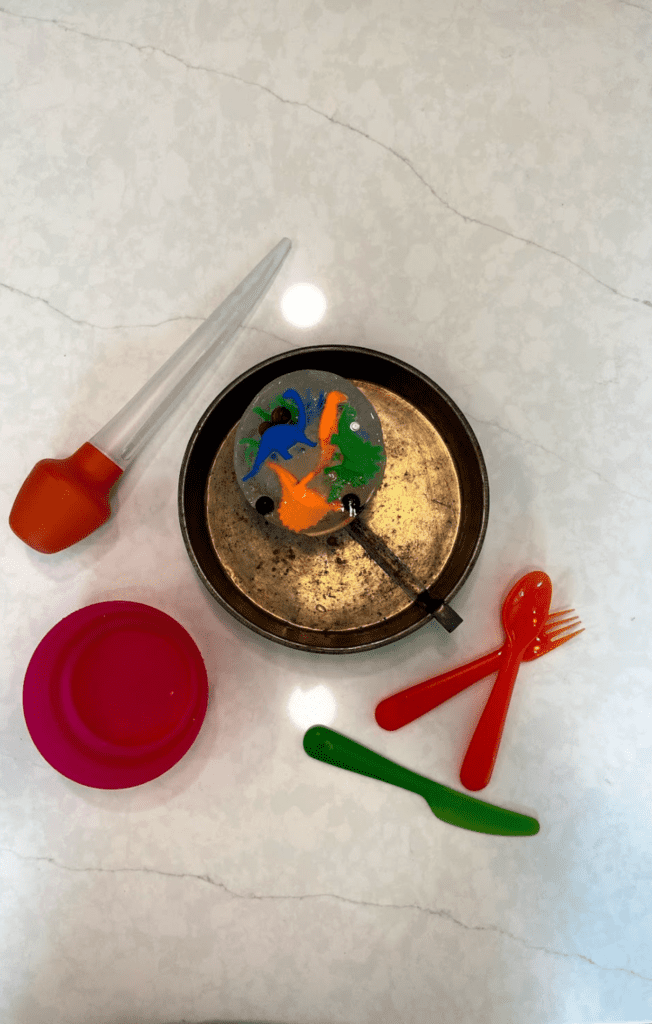
Ideas for tools to melt the ice
I always encourage the kiddos to problem-solve and use their creative minds to think about what could melt the ice the fastest. You might also show them a little video about how scientists uncover hidden materials from the ice during real-world ice excavations!
If you’re doing this with a larger group of kids, I would suggest you prepare a bin of suggested materials and opening it up to them for additional ideas. But, if you’re at home with only a few kids, let them lead!
But, if they need some prompts, here are some tools they could use:
- Spray bottles or squeeze bottles filled with hot water
- Paint brushes, spoons, and/or a turkey baster
- Small hammers or chisels
- Bowl of salt
- Warm water
- Cold water (if you’re doing this experiment in winter, you could see what happens when you spritz cold water! Challenge them to see if they can freeze two ice blocks together using nothing but water and the outside air)
After they try a few tools, ask them “what did you discover?” “which tool worked best to make the ice melt?”.
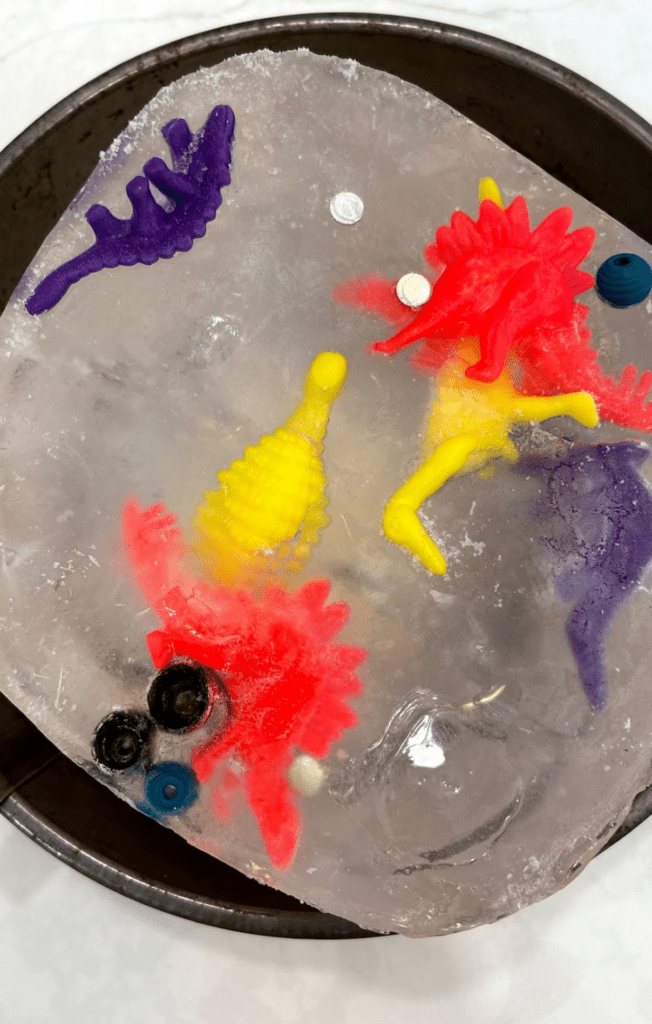
What should I freeze in the ice block?
Whatever you would like! (Helpful, I know). I sometimes like to create a “theme,” like ocean animals or dinosaurs. Sometimes I’ll do letters and numbers. Or, you can just use whatever random craft supplies you’ve got on hand.
Aim for diverse textures and shapes for increased sensory play. Items like pom poms, beads, and figurines are all fun to try to excavate from the ice!
What age is this activity for?
The ice excavation activity is a great way for toddlers to have fun while they learn about science. But, this activity can be easily adapted to different age groups and abilities, making it a versatile learning tool for any classroom. If you’re working with older kids, you can do a similar activity but turn it into a STEM challenge (perhaps a melting race?!) and really emphasize the states of matter science that are going on here. Older children will be able to have deeper conversations about melting points.
Why should I do this activity?
Well, it’s so much fun on a hot day! We did this during a heat wave and it was a fun way to stay cool while learning. There are lots of other learning benefits other than staying cool by playing with frozen water, though!
Sensory development
As mentioned above, you can add fun textures and shapes in your ice so that the uncovered objects provide an opportunity for sensory play. Plus, having hands-on learning about the melting process lets kiddos feel the change in temperature as the ice melts. Water play is a great opportunity for sensory development!
Fine motor development
Some of the objects are quite tricky to get out! As well as using their creativity to remove the objects, the kids will need to work hard to break ice off and dig out the objects.
Science learning: States of matter
Since this activity asks children to melt ice, they get to see and experience the changing states of matter! After the activity, there’s lots of opportunity for discussion about the difference between ice and water and melting points!
Problem-solving
When I did this experiment, I only gave the little ones a handful of plastic cutlery. They quickly discovered that the ice was way too thick! So, we hypothesized ideas about how we could get the items out. This develops problem-solving and encourages creative thought.
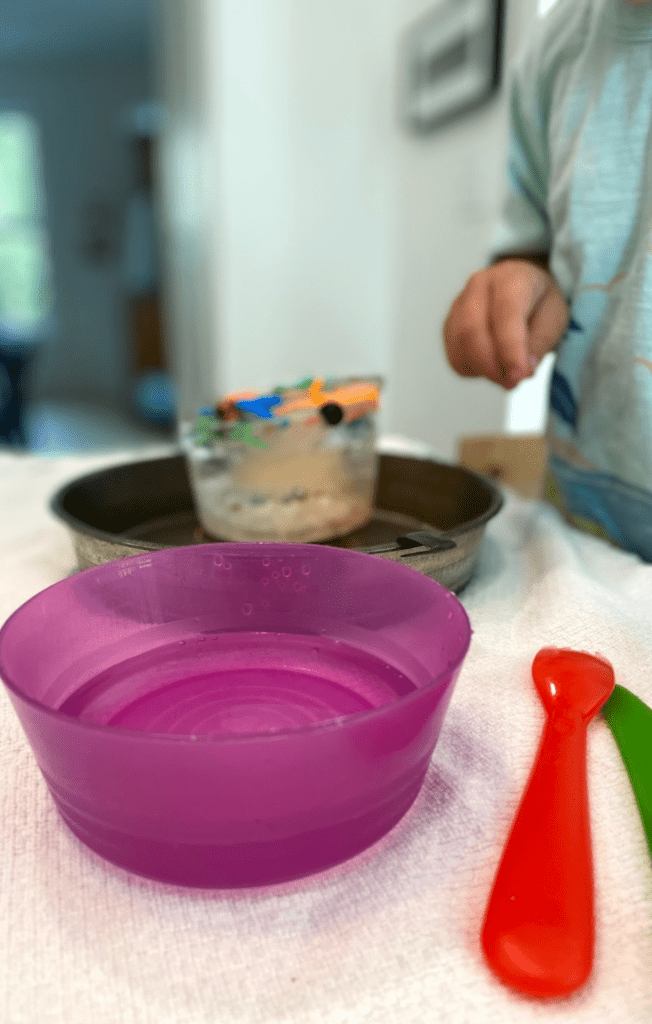
Conclusion
With just a few materials, you can create a fun ice excavation activity for toddlers where they have to work to uncover (or ‘rescue’) frozen objects from the block of ice. They will have so much fun as they explore which tools work best to uncover surprise objects, and will get to play with the fun toys they find once they’re rescued all the items! Toddlers can enjoy this as a sensory development activity while also practicing their fine motor development and problem-solving skills while learning about states of matter and melting points! Be sure to discuss what they are seeing throughout the activity by asking prompting questions.
This ice excavation activity is great as both a winter and summer activity. In the summer, it gives the children a chance to cool down while playing with the cold ice. In the winter, you could experiment with freezing the ice block outside overnight and could try excavating the materials outside as adult scientists do!
If you’re looking for more science activities for toddlers, check out our list of ideas here!
More science posts
Searching for more science experiments and science-related activities to do with your little ones? Check out this category to see all of our posts about science for kids!

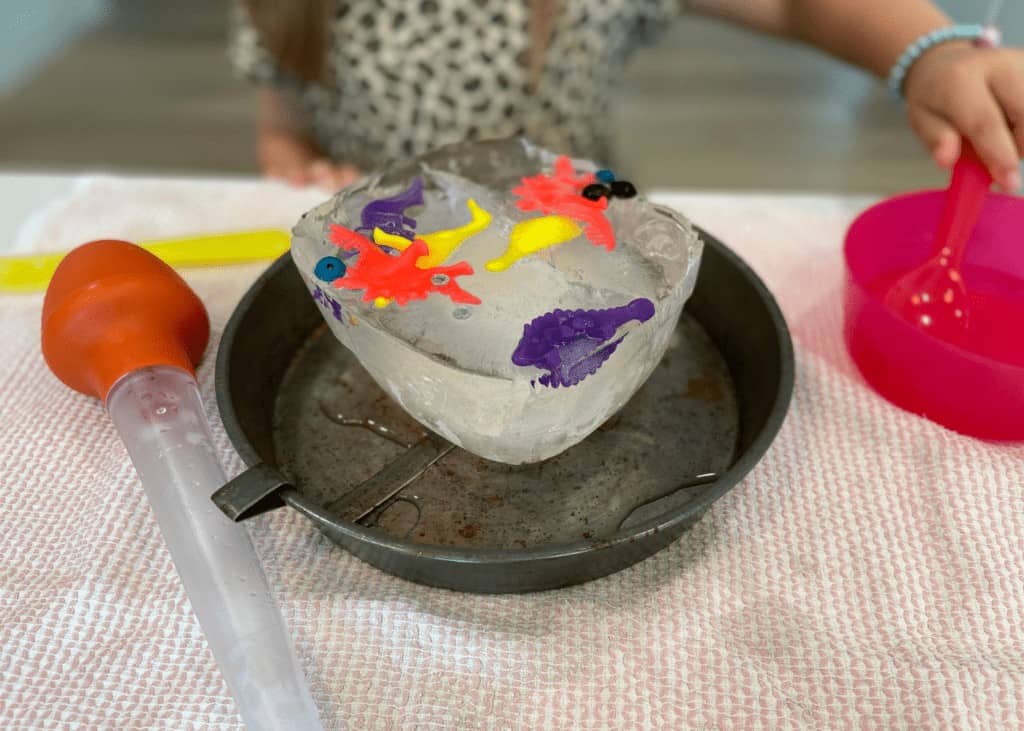
Leave a Reply